Capital Metro unveils transit system recommendations, including light rail, Austin Underground
AUSTIN, Texas - Capital Metro is one step closer to expanding its transit services for the Austin area.
On Monday, March 9, CapMetro will present its Project Connect system plan recommendation to its board of directors and the Austin City Council. The plan, designed to be a significant expansion reaching communities citywide to move more people more efficiently, includes new circulators, new and expanded MetroExpress routes, 14 new Park & Rides, and seven new MetroRapid routes as well as the Gold Line Bus Rapid Transit route.
RELATED: Capital Metro Announces Project Connect
“These recommendations are a bold vision for moving people today and planning for the future of our growing region,” said president and CEO Randy Clarke. “Thank you to our community for the significant level of engagement in this process. Our community made it clear that they are ready for action, and this plan is the beginning of a mobility transformation that will improve the quality of life for everyone. We would not be here without our partners at the City of Austin, and we’re incredibly grateful for their partnership.”
CapMetro is also recommending a light rail as the primary mode of transit for the proposed Orange and Blue lines and also envisions light rail going underground in downtown. The light rail would consist of high-capacity transit vehicles accommodating up to four times more passengers per trip than a standard bus, says CapMetro.
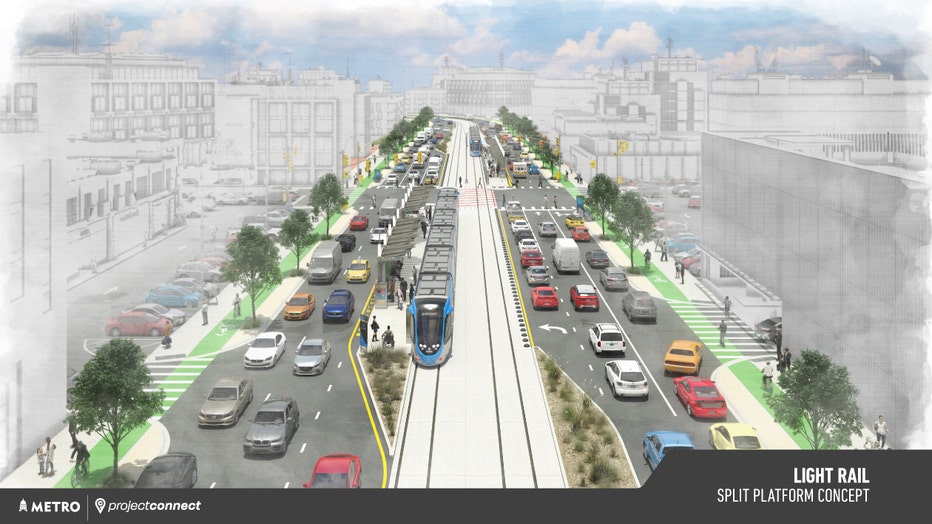
High-capacity transit vehicles accommodating up to four times more passengers per trip operating in a transitway – dedicated transit-only lanes that operate free from street traffic – than a standard bus, moving more people faster, safer, more reliab (Capital Metro)
The proposed Orange Line would entail a light rail from the North Lamar Transit Center (183 & N. Lamar) along the North Lamar/Guadalupe corridor, UT campus, downtown to Lady Bird Lake and along South Congress to Stassney Lane, along with a MetroRapid bus service from the North Lamar Transit Center to Tech Ridge and Stassney to Slaughter. The eventual plan for the MetroRapid routes would be to convert them to a light rail, approximately in the 2040s, says CapMetro.
RELATED: Cap Metro's 'Orange', 'Blue' Lines could be very different types of transit for Austin
The proposed Blue Line would entail a light rail to and from Austin-Bergstrom International Airport, providing service along East Riverside Drive, across Lady Bird Lake to the Convention Center and west along 4th Street to Republic Square, operating along the Orange Line to US 183/North Lamar.
With the light rail comes the idea for an Austin Underground Transit Tunnel, which CapMetro says would separate light rail from downtown traffic, allowing the LRT vehicles to move faster, safer and more reliably through downtown. Light rail on both lines, orange and blue, would use the 1.6-mile tunnel, and stations would feature enhanced amenities, such as retail, restaurants, a transit store and service center, and public restrooms.
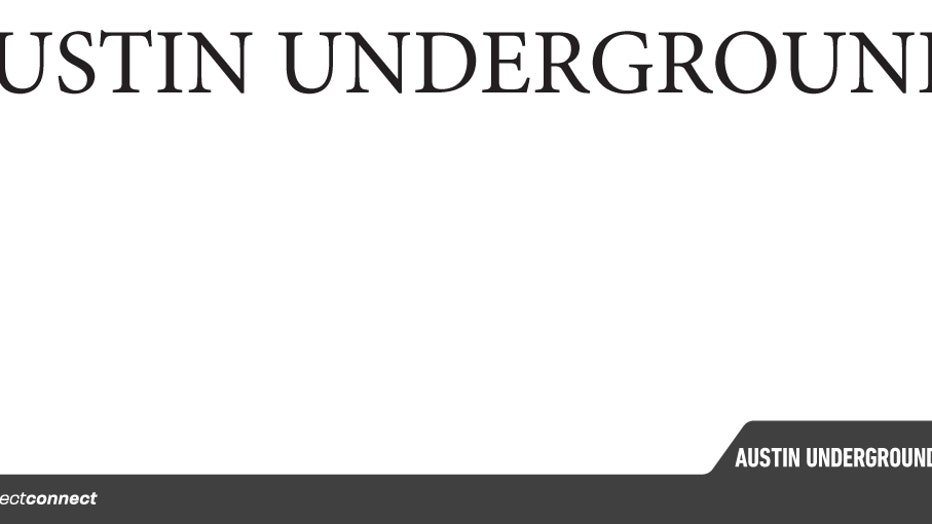
Austin Underground Transit Tunnel separates light rail from downtown traffic, allowing the LRT vehicles to move faster, safer and more reliably through downtown. (Capital Metro)
RELATED: FOX 7 Discussion: Mayor Adler on Project Connect
In addition to the new Orange and Blue Lines, CapMetro is looking at expanding the Red Line in North Austin and adding a Green Line in East Austin. The first phase of the Red Line expansion would add two new stations at the Austin FC soccer stadium and adjacent to the Domain and a second phase would include additional sections of double-tracking to improve frequency and hours of service and longer station platforms for increased train capacity.
The Green Line would be a new commuter rail line operating on an existing freight track and will connect neighborhoods throughout East Austin. The first phase would run from downtown to Colony Park. The next phases would go further east to Manor and possibly Elgin.
CapMetro is also recommending what they're calling "Bus Rapid Transit," or high-capacity transit vehicles operating on dedicated transit-only lanes that operate free from street traffic. This includes the Gold Line, which would be from Austin Community College’s Highland campus through downtown to the Convention Center and Republic Square.
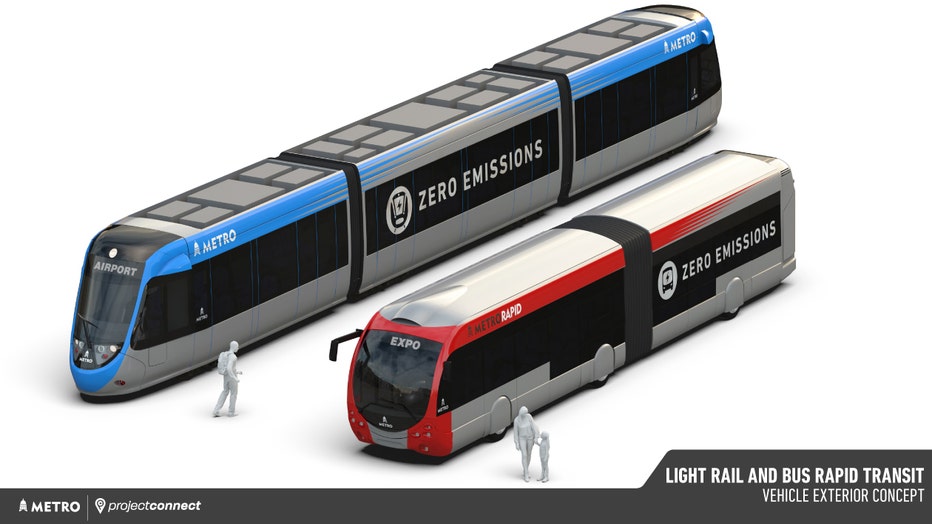
CapMetro is committing to a cleaner future with an entire fleet of vehicles that are zero emissions. Both BRT and LRT vehicles will have boarding from multiple doors, and new features would include interior bike racks, on-board digital information ce (Capital Metro)
RELATED: FOX 7 Discussion: Cap Metro CEO on Project Connect
In addition to these, CapMetro is looking at adding seven new MetroRapid routes in three phases. Phase one would include the Expo Center and Pleasant Valley routes, as well as a southern extension of the 803 to Oak Hill and Menchaca. Phase two would include the Crosstown, MLK, and ACC to Tech Ridge routes. Phase three would include the Parmer route.
CapMetro also wants to add 14 new Park & Rides with improved connection options and amenities. Some locations could include bike shelters and electric vehicle charging.
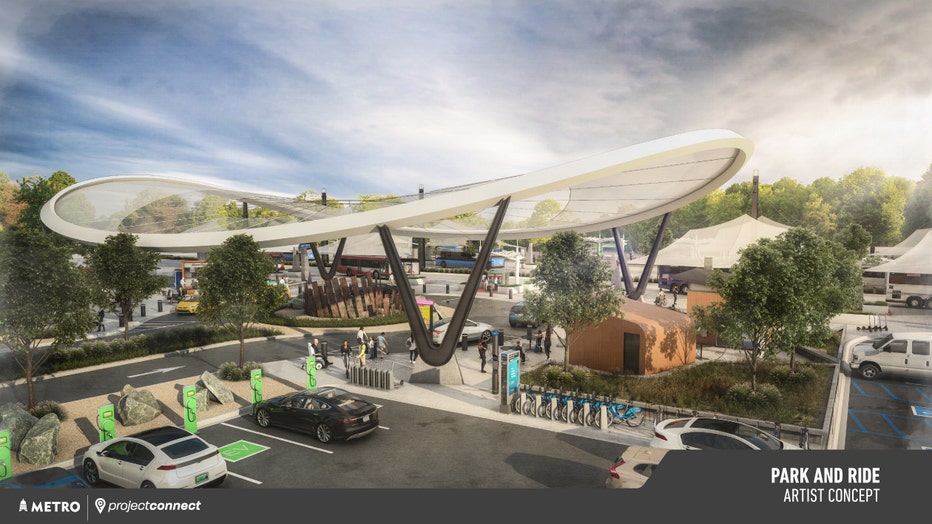
Enhanced customer amenities are planned for future park & rides, including food vendors, charging for electric vehicles, and access to rentals for bikes, scooters and other new transportation choices. Ample shade and seating areas add a greater l (Capital Metro)
New circulators are also planned so customers could use the service to connect to their favorite neighborhood spots and access additional transit options, like CapMetro's Pickup provides today. CapMetro also plans to purchase additional all-electric, zero-emission MetroBuses and continue to upgrade stops with digital signage and safety lighting.
The recommendations come after two years of community engagement, six public joint work sessions between the board and City of Austin, a Technical Advisory Committee and Ambassador Network and an independent third-party review.
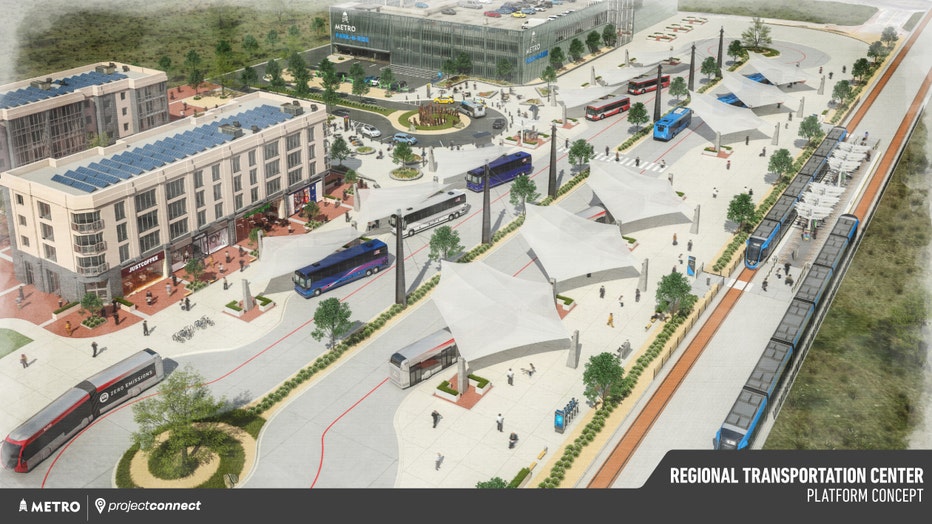
This type of facility would link to all services in the transit network, including other transit providers connecting residents to Texas cities outside the Austin area. The property could include space for mixed-use retail and housing, public art dis (Capital Metro)
“This has been one of the most transparent processes ever conducted in our city,” said Wade Cooper, Chair of the Capital Metro Board of Directors. “The board hired our President and CEO Randy Clarke to develop a data-driven and community-supported transit plan. We now have a real solution to address one of our city’s biggest challenges.”
Following additional public input over the next two months, the board and City Council are expected to finalize the transit plan and funding options in May.


